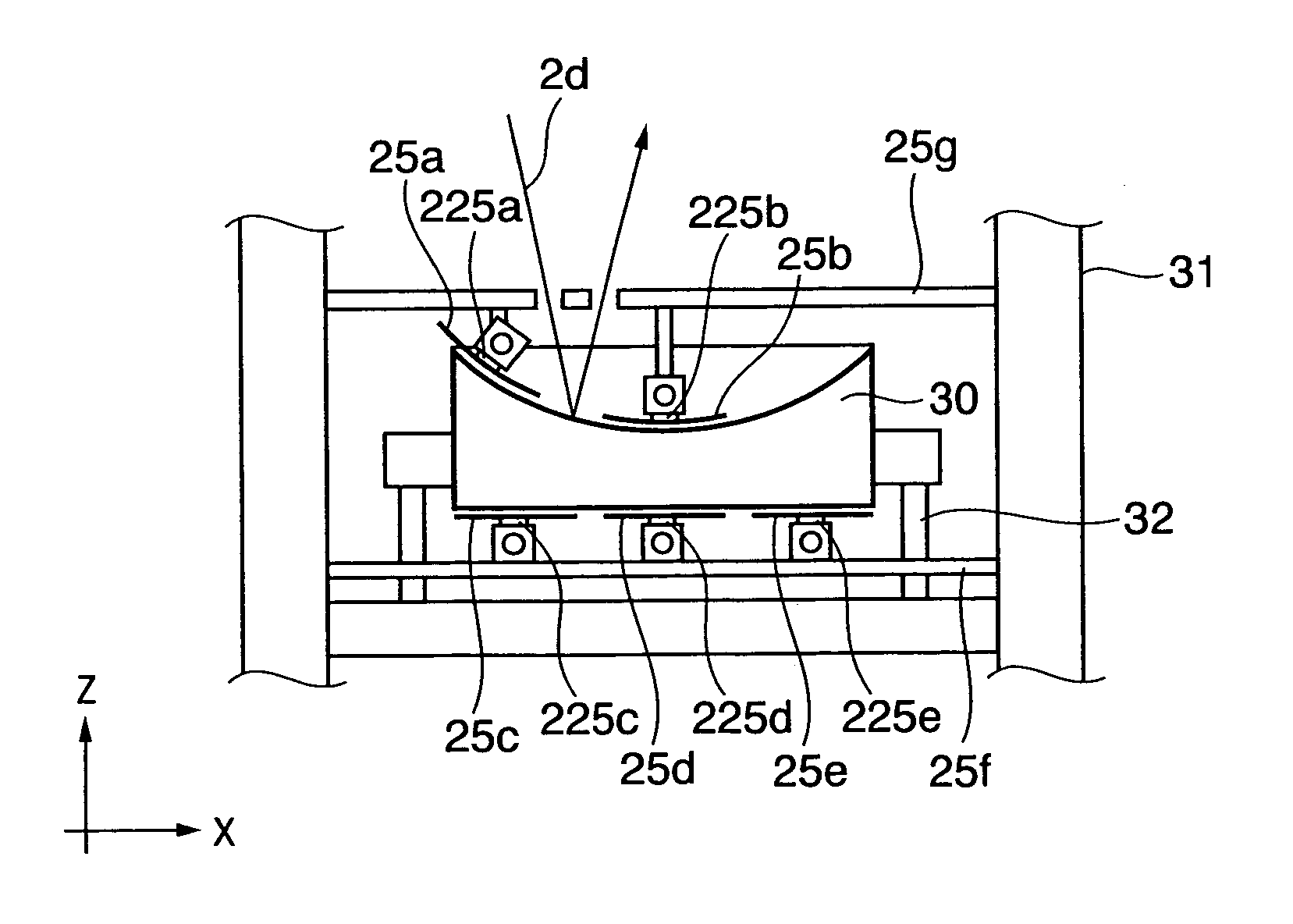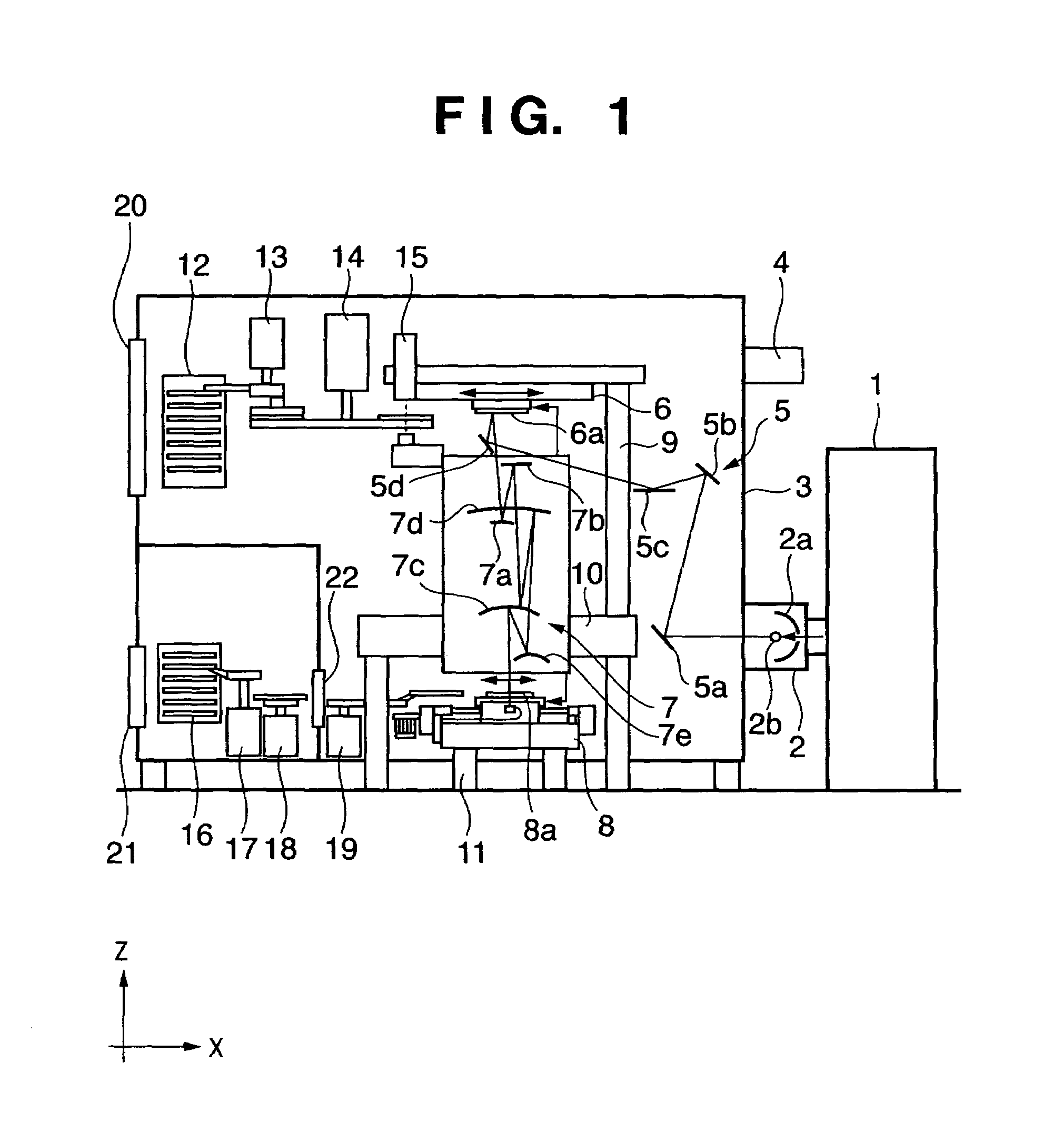Reflection mirror apparatus, exposure apparatus and device manufacturing method
a technology of reflection mirror and exposure apparatus, which is applied in the field of exposure apparatus, can solve the problems of affecting the image formation performance and illumination performance of the wafer, the inability to use the optical control system using an optical lens, and the inability to ensure the accuracy of the surface form of about 1 nm,
- Summary
- Abstract
- Description
- Claims
- Application Information
AI Technical Summary
Benefits of technology
Problems solved by technology
Method used
Image
Examples
first embodiment
[0026]FIG. 1 is a schematic cross-sectional view showing the structure of an exposure apparatus according to a first embodiment of the present invention. In FIG. 1, reference numeral 1 denotes an excitation laser. The laser is emitted toward a point where a light source material is gasified, liquefied or spray-gasified, as a light emission point of light source, for plasma excitation of atoms of the light source material, thereby emitting extreme ultraviolet light. In the present embodiment, a YAG solid laser or the like is used as the excitation laser.
[0027]Numeral 2 denotes a light source unit having a structure in which a vacuum status is maintained. FIGS. 2A and 2B show the internal structure of the light source unit 2. Numeral 2b denotes a light source indicating an actual light emission point of exposure light source. Numeral 2a denotes a light source mirror which gathers all the light from the light source 2b and reflects the light in a light emission direction, thus generati...
second embodiment
[0055]FIG. 6 shows the cooling mechanism according to a second embodiment of the present invention. In FIG. 6, constituent elements corresponding to those in the first embodiment (FIG. 3B) have the same reference numerals. In the first embodiment, plural separate radiation plates are provided for the exposure light reflection surface and the rear surface of the mirror, and respectively optimized temperature-control cooling media are passed through the respective radiation plates. In the second embodiment, as shown in FIG. 6, radiation plates 125a and 125b are simply separated for the exposure light reflection surface and the rear surface of the mirror 30. Note that the radiation plate 125a is provided with an opening (not shown) to ensure a passage area for the exposure light 2d incoming and outgoing to / from the reflection surface of the mirror 30. Further, the cooling mechanism having this form is preferably used in a portion where the amount of exposure light incident on the mirro...
third embodiment
[0058]FIG. 7 shows the cooling mechanism according to a third embodiment of the present invention. In FIG. 7, constituent elements corresponding to those in the first embodiment (FIG. 3B) have the same reference numerals. In the first embodiment, the cooling pipes are directly connected to the radiation plates so as to directly cool the radiation plates. In the third embodiment, Peltier elements 225a to 225e as solid heat-transfer elements are provided between the radiation plates 25a to 25e and the cooling pipes 23a to 23e. As shown in FIG. 7, it may be arranged such that the temperature control of the radiation plates is performed by the Peltier elements, and temperature rising portions in heat radiation portions on the rear surfaces of the Peltier elements are cooled by the cooling media in the cooling pipes.
PUM
| Property | Measurement | Unit |
|---|---|---|
| wavelength | aaaaa | aaaaa |
| reflectivity | aaaaa | aaaaa |
| temperature | aaaaa | aaaaa |
Abstract
Description
Claims
Application Information
 Login to View More
Login to View More - R&D
- Intellectual Property
- Life Sciences
- Materials
- Tech Scout
- Unparalleled Data Quality
- Higher Quality Content
- 60% Fewer Hallucinations
Browse by: Latest US Patents, China's latest patents, Technical Efficacy Thesaurus, Application Domain, Technology Topic, Popular Technical Reports.
© 2025 PatSnap. All rights reserved.Legal|Privacy policy|Modern Slavery Act Transparency Statement|Sitemap|About US| Contact US: help@patsnap.com



